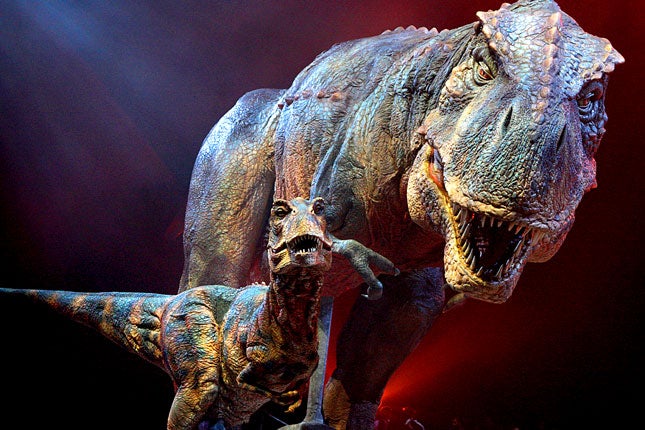The joy of rex: Are documentaries becoming sexed-up?
Tonight, dinosaurs' mating habits will be explored on our screens. Will we learn anything or is it just the latest in a long line of sexed-up documentaries?

Your support helps us to tell the story
From reproductive rights to climate change to Big Tech, The Independent is on the ground when the story is developing. Whether it's investigating the financials of Elon Musk's pro-Trump PAC or producing our latest documentary, 'The A Word', which shines a light on the American women fighting for reproductive rights, we know how important it is to parse out the facts from the messaging.
At such a critical moment in US history, we need reporters on the ground. Your donation allows us to keep sending journalists to speak to both sides of the story.
The Independent is trusted by Americans across the entire political spectrum. And unlike many other quality news outlets, we choose not to lock Americans out of our reporting and analysis with paywalls. We believe quality journalism should be available to everyone, paid for by those who can afford it.
Your support makes all the difference.Ever pondered the sexual dimensions of a male dinosaur? Perhaps, but that doesn't matter because, thanks to palaeobiologists, we now know that Tyrannosaurus rex boasted a 6ft-long penis (the John Holmes of the prehistoric world was the titanosaurus, with 12ft).
And we can be grateful to new research that has worked out that dinosaurs performed complex mating rituals that included dances and displays of plumage. The creatures also used mating calls and pheromones to attract the opposite sex. The study surmises that dinosaur sex organs would have most closely resembled those of crocodiles, that they mated standing up, and that the male T. Rex would have bitten its mate to stop her running away because his arms were too short to hold her effectively.
These details are presented in the snappily titled Tyrannosaurus Sex (Discovery Channel, tonight, 9pm), which uses expert research and cutting-edge CGI to bring to life the mating habits of creatures which have been extinct for millions of years. You've seen Walking with Dinosaurs; now enjoy "Bonking with Dinosaurs"; it even comes with a graphic-content warning.
Why make a documentary on such a seemingly niche subject? Kristi Curry Rogers, an assistant professor of biology and geology at Macalester College in Minnesota, explains: "One question people really want to know is, exactly how did dinosaurs have sex?"
The answer, in the case of the armour-plated, spike-tailed stegosaurus, is "very carefully".
Some questions, however, are set to remain unanswered.
"We don't know enough about what dinosaurs were thinking to know whether they were having orgasms," laments Ms Curry Rogers.
Sex evidently sells in the case of dinosaurs, but has the natural history genre become sexed up? In prehistoric documentaries, special effects and CGI are now commonplace and bring the subjects to life for audiences who have come to expect the thrill of computer imagery.
Dan Korn, the Discovery Channel's head of programming, explains: "Audiences go to the cinema and see films like Jurassic Park, and if TV slips too far below that benchmark, there is a problem. They want to see strong special effects in their front rooms."
A scan down the listings suggests the wildlife landscape has also changed since the days when Sir David Attenborough could stand in the foreground and deliver narration to camera with a disinterested polar bear looking on in the distance. With titles such as Hollywood's Killer Bear, Monster Jellyfish Attack, Fishzilla, Shark Bite Beach and Ultimate Air Jaws, the emphasis is on the extreme.
While there is still a voracious appetite for big-budget kite-mark documentaries such as the BBC's Blue Planet and Werner Herzog's Encounters at the End of the World, modern programme makers also have to think creatively when it comes to subject matter. If there are not enough dissections of unusually large cephalopods on television for you, they have the answer: Inside Nature's Giants, where vets perform autopsies on creatures such as elephants, whales and giant squid. With skilful execution, the series won a Bafta and proved that sensational can be educational and entertaining.
There is a flip side to this quest for the remarkable, however. The wildlife documentary maker Chris Palmer alleges that natural history programme makers often cheat. In his book Shooting in the Wild, he reveals how some film-makers use wild animals that aren't quite wild, filmed in nature that isn't entirely natural. He accuses one presenter of baiting animals into combat and asserts that "if you see a bear feeding on a deer carcass in a film, it is almost certainly a tame bear searching for hidden jelly beans in the entrails of the deer stomach".
At least with the odd oversexed CGI T. Rex, you know what you're getting.
'Tyrannosaurus Sex' is on the Discovery Channel at 9pm tonight
Join our commenting forum
Join thought-provoking conversations, follow other Independent readers and see their replies
Comments